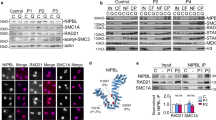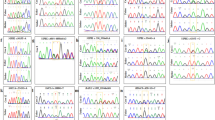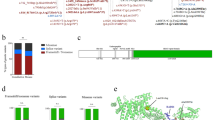Abstract
Cornelia de Lange syndrome (CdLS; OMIM 122470) is a dominantly inherited multisystem developmental disorder characterized by growth and cognitive retardation; abnormalities of the upper limbs; gastroesophageal dysfunction; cardiac, ophthalmologic and genitourinary anomalies; hirsutism; and characteristic facial features1,2,3. Genital anomalies, pyloric stenosis, congenital diaphragmatic hernias, cardiac septal defects, hearing loss and autistic and self-injurious tendencies also frequently occur2. Prevalence is estimated to be as high as 1 in 10,000 (ref. 4). We carried out genome-wide linkage exclusion analysis in 12 families with CdLS and identified four candidate regions, of which chromosome 5p13.1 gave the highest multipoint lod score of 2.7. This information, together with the previous identification of a child with CdLS with a de novo t(5;13)(p13.1;q12.1) translocation, allowed delineation of a 1.1-Mb critical region on chromosome 5 for the gene mutated in CdLS. We identified mutations in one gene in this region, which we named NIPBL, in four sporadic and two familial cases of CdLS. We characterized the genomic structure of NIPBL and found that it is widely expressed in fetal and adult tissues. The fly homolog of NIPBL, Nipped-B, facilitates enhancer-promoter communication and regulates Notch signaling and other developmental pathways in Drosophila melanogaster5.
This is a preview of subscription content, access via your institution
Access options
Subscribe to this journal
Receive 12 print issues and online access
$259.00 per year
only $21.58 per issue
Buy this article
- Purchase on SpringerLink
- Instant access to full article PDF
Prices may be subject to local taxes which are calculated during checkout



Similar content being viewed by others
References
de Lange, C. Sur un type nouveau de dégénératio (typus Amstelodamensis). Arch. Méd. Enfants 36, 713–719 (1933).
Jackson, L., Kline, A.D., Barr, M.A. & Koch, S. de Lange syndrome: a clinical review of 310 individuals. Am. J. Med. Genet. 47, 940–946 (1993).
Ireland, M., Donnai, D. & Burn, J. Brachmann-de Lange syndrome. Delineation of the clinical phenotype. Am. J. Med. Genet. 47, 959–964 (1993).
Opitz, J.M. The Brachmann-de Lange syndrome. Am. J. Med. Genet. 22, 89–102 (1985).
Rollins, R.A., Morcillo, P. & Dorsett, D. Nipped-B, a Drosophila homologue of chromosomal adherins, participates in activation by remote enhancers in the cut and Ultrabithorax genes. Genetics 152, 577–593 (1999).
Hulinsky, R. et al. Prenatal diagnosis dilemma: fetus with del(5)(p13.1p14.2) diagnosed postnatally with Cornelia de Lange syndrome. Am. J. Hum. Genet. 73 Suppl., 602 (2003).
Ganguly, A., Rock, M.J. & Prockop, D.J. Conformation-sensitive gel electrophoresis for rapid detection of single-base differences in double-stranded PCR products and DNA fragments: evidence for solvent-induced bends in DNA heteroduplexes. Proc. Natl. Acad. Sci. USA 90, 10325–10329 (1993).
Ciosk, R. et al. Cohesin's binding to chromosomes depends on a separate complex consisting of Scc2 and Scc4 proteins. Mol. Cell 5, 243–254 (2000).
Neuwald, A.F. & Hirano, T. HEAT repeats associated with condensins, cohesins, and other complexes involved in chromosome-related functions. Genome Res. 10, 1445–1452 (2000).
Li, L. et al. Alagille syndrome is caused by mutations in human Jagged1, which encodes a ligand for Notch1. Nat. Genet. 16, 243–251 (1997).
Bulman, M.P. et al. Mutations in the human delta homologue, DLL3, cause axial skeletal defects in spondylocostal dysostosis. Nat. Genet. 24, 438–441 (2000).
Kruglyak, L., Daly, M.J., Reeve-Daly, M.P. & Lander, E.S. Parametric and nonparametric linkage analysis: a unified multipoint approach. Am. J. Hum. Genet. 58, 1347–1363 (1996).
Krantz, I.D. et al. Deletions of 20p12 in Alagille syndrome: frequency and molecular characterization. Am. J. Med. Genet. 70, 80–86 (1997).
Kawauchi, S. et al. Regulation of lens fiber cell differentiation by transcription factor c-Maf. J. Biol. Chem. 274, 19254–19260 (1999).
Acknowledgements
We thank the individuals with CdLS and their families for their support and willingness to donate samples; the Cornelia de Lange Syndrome Foundation, their staff and their director J. Mairano for their support; and N. Spinner, M. Jackson, A. Kline, J. Morrissette, M. Budarf and the staff of the clinical cytogenetics laboratory and the sequencing core at The Children's Hospital of Philadelphia for their comments and guidance. This work was supported by grants from the National Institutes of Health, National Institute of Child Health and Human Development (to I.D.K., M.D., A.D.L. and A.L.C.).
Author information
Authors and Affiliations
Corresponding author
Ethics declarations
Competing interests
The authors declare no competing financial interests.
Rights and permissions
About this article
Cite this article
Krantz, I., McCallum, J., DeScipio, C. et al. Cornelia de Lange syndrome is caused by mutations in NIPBL, the human homolog of Drosophila melanogaster Nipped-B. Nat Genet 36, 631–635 (2004). https://doi.org/10.1038/ng1364
Received:
Accepted:
Published:
Issue date:
DOI: https://doi.org/10.1038/ng1364
This article is cited by
-
The multifaceted roles of cohesin in cancer
Journal of Experimental & Clinical Cancer Research (2022)
-
Functional crosstalk between the cohesin loader and chromatin remodelers
Nature Communications (2022)
-
Large-scale multi-omics analysis suggests specific roles for intragenic cohesin in transcriptional regulation
Nature Communications (2022)
-
Subclinical myocardial dysfunction is revealed by speckle tracking echocardiography in patients with Cornelia de Lange syndrome
The International Journal of Cardiovascular Imaging (2022)
-
Genome folding through loop extrusion by SMC complexes
Nature Reviews Molecular Cell Biology (2021)



